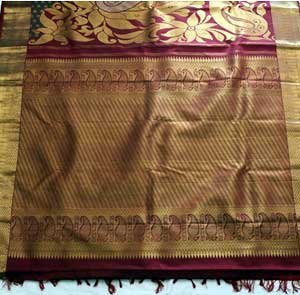India has a rich tradition of handloom with each state and region known for weaving fabrics unique and peculiar to it. Pashmina Shawl typical to Leh, Ladakh and Kashmir Valley, Kulllu Shawl of Himachal Pradesh, Phulkari and Panja Weave of Panjub, Panchachuli Weave of Haryana, Shisha weave of Rajasthan, famous Benarashi and Chikankari of Uttar Pradesh, Bhagalpuri Silk of Bihar, Bandhani of Gujarat, Paithani of Maharashtra, Mysore Silk of Karnataka, Kasavu of Kerala, Kanjeevaram and Kalamkari of Tamilnadu, Pochampally of Telengana and Andhra Pradesh, Chanderi and Maheswari of Madhya Pradesh, Single and Double ikat of Sambalpur, Odisha, Jamdani of West Bengal, Muga Silk of Assam, Naga Shawl of Nagaland, Rhea and Pachhra of Tripura, Puan Cloth woven on loin loom in Mizoram, all represent a wide range of hand woven fabrics typical to India.
Spreading from Kashmir to Kanyakumari and Kuchh to Cachar, each region of the country has its unique handloom product, which truly reflects the “Unity in Diversity” that India is known for and makes every Indian proud. Continuing and conserving this rich heritage is a national task, which requires active support of the consumers, and producers, duly supplemented by efforts of the central and state governments. Apart from meeting one of the basic needs of human being, handloom forms an important component of the culture and tradition and a pride possession of its owners. In fact, handloom fabrics, known for its rich design, became a source of envy for the foreign rulers apart from the gold and diamond jewellery and spices. There is reference to chopping off fingers of the skilled weavers of Bengal for protecting the British textile industry. However, industrial revolution led developments with production of fabrics in bulk in the power loom and composite mills affected the status of the India handloom industry adversely on a continuous basis over the past decades.
As per the Third Handloom Census (2009-10), the number of handloom fell to 23.77 lakh, by 31.8% from the Second Handloom Census (1995-96). Number of handloom weavers and workers similarly declined to 43.31 lakh by 33.8% from the previous census. However, the share of fulltime weavers increased from 44% (in the second census) to 64% (in the third census). Latter is a positive development indicating that while the total number of handloom and handloom weavers has been decreasing, percentage of weavers pursuing handloom on a fulltime basis have increased. Further, the facts that over 70 % of the weavers are women and majority of the weavers belong to the backward classes make the industry of considerable social significance.
Notwithstanding the fact that handloom forms a part of the tradition and culture, in a free market economy the strength of a product depends on its quality and price, as compared with competing products of similar nature. Share of fabrics woven with manmade fibre in power looms and composite mills has been increasing steadily supported by new technology. In order to compete with such fabrics in a free market, handloom is required to be strengthened based on its unique nature in respect of quality and new designs. Emergence of the urban middle class with sizable disposable income has opened a new window of opportunity for the handloom products, particularly from well-to-do customers looking for ethnic product of unique nature. This will help handloom in facing the competition from power loom and mill-made fabrics. This has necessitated empowering the handloom weavers adequately with financial and technical support, handholding and recognition for development on a sustainable basis by exploiting its own strength rather than depending upon subsidy based crutches.
Prime Minister Narendra Modi, who took personal interest in promotion of Khadi and Handloom as a matter of national pride on the one hand and for providing livelihood to lakhs of handloom weavers depending on this age old industry on the other. A two prong approach for development of the handloom industry was taken up covering giving social recognition to the handloom weavers and enabling the weavers to weave unique quality products for increasing his earning substantially. These measures envisage attracting the young generation to continue in the profession.
Recently, Second National Handloom Day was observed at Varanasi, an important centre of handloom production. Spirit of handloom of Varanasi is reflected in aspirations of every Indian parent to see their daughter in Banerashi attire on her wedding day. The Third National Handloom Day is scheduled be held at Guwahati, another important handloom centre known for the famous golden Muga fabric with bright colour designs of Sualkuchi, Assam.
Handloom product of India represents an inseparable part of our rich culture and tradition and act as a source of livelihood for millions engaged in this activity. This development is a continuous process and requires active cooperation of all the stakeholders, viz. (a) the handloom weavers in producing fabric with new design and quality as per the liking of the customer, (b) the industry supplying raw material for ensuring quality and at a reasonable price, (c) the financial institutions for providing capital at a reasonable rate of interest and simple procedure, and (d) e-commerce agencies for marketing with low transaction cost, etc. The government agencies, particularly the Ministry of Textiles, the Development Commissioner (Handloom) with the network of Weavers Service Centre and the state departments dealing with promotion of handloom are required to assist the weavers with commitment, compassion and due recognition. The common consumer need to support by wearing handloom on at least one day in a week, in addition to festivals and ceremonies, which will give them the feeling of being Indian and contributing to welfare and livelihood of the talented weavers.
(Author is former Secretary, Ministry of Textiles. Views expressed in the article are his own.)

















Related Items
Operation Sindoor: India’s fiery rebirth as a Unified Hindu Civilisation
AI or human reviews are indistinguishable to customers!
Unsafe environment, colonial policing are chief threats to human rights